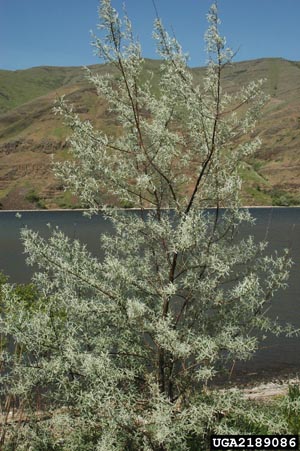Russian Olive

Common Name(s):
Russian Olive
Oleaster
Scientific Name:
Elaeagnus angustifolia L.
Scientific Name Synonyms:
None known
Symbol:
ELAN
Description:
Life Span: Perennial
Origin: Introduced
Season: Deciduous
Growth Characteristics: Russian olive is a shrub or small tree usually 12 to 45 feet tall. It can grow up to 6 feet per year. It forms a dense, rounded crown. Near the ground its branches spread from 10 to 20 feet. Unpruned trees have five or six main stems starting near the ground. It reproduces from seed and by root sprouting.
Flowers/Inflorescence: Flowers are small, yellow, and very fragrant, borne in teh axils of the leaves.
Fruits/Seeds: Fruit is a light grayish-green olive-shaped drupe.
Leaves: Linear, light green above, gray below, 1.7 to 3.5 inches long. The leaves are covered with scalelike, stellate pubescence, giving it the appearance of silvery scales.
Stems: The twigs of Russian olive are flexible, coated with a gray, scaly pubescence and have a thorn at the end. Bark is reddish-brown and thin, with shallow fissures, and exfoliates into long strips.
Ecological Adaptions:
Russian olive is commonly found growing along floodplains, riverbanks, stream courses, marshes, and irrigation ditches in the West at elevations from 4500 to 6000 feet. It is tolerant of considerable amounts of salinity or alkalinity, and can survive considerable droughts.
Russian olive sprouts from the root crown and sends up root suckers.
Soils: Russian olive thrives under a wide range of soil textures from sand to heavy clay, and can withstand flooding and silting. It grows best in deep sandy or loamy soils with only slight salt and alkali content.
Associated Species: Saltgrass, cheatgrass, peppergrass, big sagebrush, buffalo berry, prickly lettuce.
Uses and Management:
Russian olive has no forage value for livestock or big game, although both browse the foliage at times. Wild fowl and game birds eat the fruit, and the tree is used for cover and protection. More than 50 species of birds and mammals eat the fruit of Russian olive. Beavers use Russian olive branches for dam-building material. It is often used in windbreaks.
In general, Russian olive-dominated communities provide inferior wildlife habitat to that of native riparian vegetation. Russian olive can interfere with agricultural practices and can displace native riparian vegetation. It rapidly colonizes lowland fields, often chokes irrigation ditches, and damages tires and equipment. The impact of Russian olive may be severe in some locations. It has been declared a noxious weed in parts of Utah.
Once established Russian olive is difficult to control and nearly impossible to eradicate. Efforts to control unwanted concentrations of Russian olive have included mowing seedlings, cutting, burning, spraying, girdling, and bulldozing. Most efforts have realized limited success. Apparently the most effective combination of control efforts has been cutting trees, followed by either spraying or burning the stumps.

